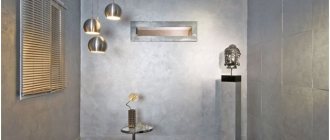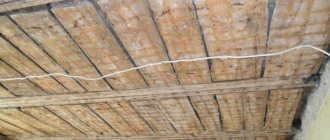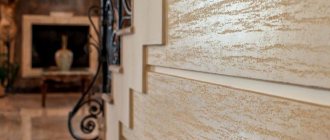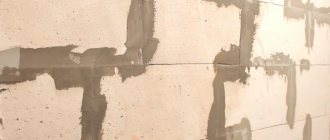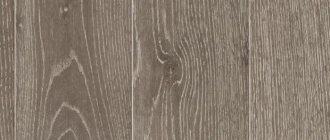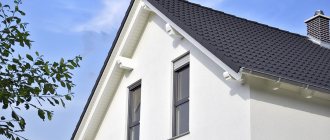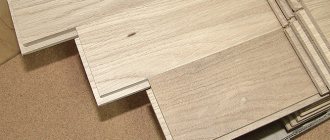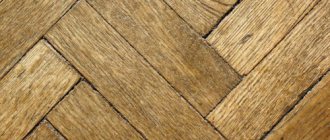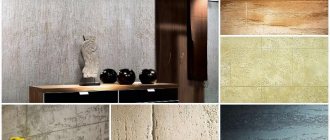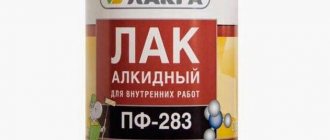After laying parquet, the question arises of how to properly treat it to protect it from moisture. Usually a special varnish or oil is used for parquet, depending on operating conditions and personal preferences. It should be taken into account that after covering the parquet with oil, you will have to use only it in the future, since the varnish in this case will no longer adhere to the surface even after deep sanding.
The oil has its drawbacks, so before using it you need to be firmly convinced of its necessity
No. 1. What is it common to cover parquet floors with?
Surely, you know the differences between parquet boards, piece parquet and solid boards , but we’ll repeat it just in case. Piece parquet is solid wood, cut into planks with grooves and tenons; it can be sanded numerous times. Block parquet can be laid in a complex pattern to form interesting patterns or designs. Solid board is almost the same as piece parquet. Sometimes it is called massive parquet. The only difference lies in the size - a solid board is larger, and therefore it is impossible to lay it in an artistic way. Parquet board is a three-layer material, where only the top layer is made of valuable wood species, the middle and bottom layers are made of cheaper coniferous species. This material is cheaper, but less durable.
Typically, piece and solid parquet are sold without treatment - you can choose whether to coat the material with varnish or oil. However, already varnished parquet is also found. Parquet boards, on the contrary, are often sold already processed. All that remains is to lay it down, and the floor finishing is ready - convenient and quick. Manufacturers' collections are, of course, extensive, but it is not always possible to find a suitable shade, so today there is a tendency to sell parquet boards without coating, so that everyone can decide for themselves what is best to cover it with.
Typically, the following materials are used to protect wood:
- varnish is the most durable and popular coating. Varnish forms a film on the surface of the wood, protecting it from moisture. If repairs are needed, the varnish layer can be cleaned off and then treated with either a new layer of varnish or oil. True, local repairs will be difficult to carry out - you will have to scrape the coating in the entire room and reapply the protection. In addition, coating parquet with varnish is time-consuming and difficult. The varnish coating can be damaged by metal heels, furniture legs and liquids containing alcohol, so precautions must be taken in time;
- the oil does not create a film on the surface; it penetrates into the structure of the wood, allowing it to breathe. A floor treated with oil looks more natural, the application process itself is much simpler than in the case of varnish, and repairs are easier to carry out. We'll talk about other nuances of use below;
- wax is usually applied in combination with oil, on top of it. Less commonly used as a stand-alone coating. Wax gives the wood a pleasant shine and additionally protects its surface.
Wax and oil are more natural and environmentally friendly materials; they allow you to preserve the unique natural properties of wood to the maximum, giving it additional protective characteristics.
How to cover and protect wooden floors in an apartment or house
Plank flooring is considered the best finishing coating in terms of functionality and aesthetics. In country houses this is the most optimal solution. However, during operation, natural boards can deteriorate and become deformed under the influence of external factors. It is important to find out what to cover the wood floors in your home to maintain its integrity and decorative appeal.
Why do we need board protectors?
Natural wood is an excellent material for flooring. This is a traditional solution for houses located in frosty northern climates. They retain heat well and allow you to create comfortable living conditions in the house.
But wood is a fancy material. Even after mechanical processing, it lives its own life. Actively absorbs moisture. If there is a lot of it, then the wood begins to rot. At high temperatures it shrinks and warps. When low, it “narrows.” Cracks appear between the boards. The floorboards are coming apart and creaking.
Insects and pests actively eat natural material. They leave numerous passages in the boards, turning the natural structure into dust. Fungus and mold paint the floorboards an unpleasant blue-gray color, gradually destroy them and create an unfavorable microclimate throughout the room. People in it start to get sick.
To avoid unpleasant consequences and keep the surface of natural boards in good condition, you should think about how to cover a wooden floor.
No. 2. How does parquet oil work?
If the varnish creates a protective film on the surface of the wood, then the oil penetrates into the wood , into its pores and remains there, only a small amount remains on the surface. Oil and varnish protect wood approximately equally from the harmful effects of moisture: neither one nor the other material is capable of providing one hundred percent protection. The difference is that varnish complicates the natural processes of moisture exchange between parquet and air. Wood absorbs and releases moisture - this is a normal process. Oil does not prevent this from happening, but varnish makes it difficult to remove excess moisture. The result is the appearance of peeling and cracks on the wood, damage to the varnish layer.
It turns out that oil protects wood no worse than varnish, but at the same time provides the wood with greater durability. Before choosing oil for parquet as a protective coating, you must clearly understand the fact that oiled wood will be almost impossible to varnish. Sometimes multi-layer priming helps, which prevents oil from escaping, but in most cases, even such treatment will not save you from rapid peeling and cracking of the varnish.
Surface preparation before application
Coating parquet with oil is a rather complicated procedure, however, you can do it yourself. We need to start with preparation. To obtain an ideal surface, the floor must be carefully leveled. To do this, you will need a grinding machine with a whole set of sandpapers of different grain sizes. You should start with 20-grit sandpaper, gradually moving up to 150-grit. Of course, this work can be done manually, but you must be prepared for the fact that it will take a long time.
The result of grinding should be a perfectly flat surface without chips or cracks.
Important! The dust that is generated must be removed, and in no case should wet cleaning be attempted - only with a vacuum cleaner.
The parquet surface must be clean and dry, otherwise a quality result is not guaranteed.
Next, the floor is rubbed with a soft material, felt or microfiber until a smooth polished surface is obtained. Only after this can the parquet be coated with oil.
No. 3. Advantages and disadvantages
The principle of operation of parquet oil also determines the main advantages of the coating:
- treating the floor with oil is much faster and easier than with varnish. You can do all the work yourself, without having extensive experience in the field of repair work;
- if damage appears on the floor, re- treatment can be carried out locally - you do not have to remove the coating from the entire floor and re-cover its entire surface;
- oil preserves the wood's ability to breathe , which has a positive effect on its durability;
- oil protects wood well from moisture ; previously ship decks were treated with similar compounds, and this says a lot;
- oil is more resistant to abrasion than varnish, and the reason should be sought in the fact that the oil fills the pores of the wood and does not lay down as a continuous film;
- oiled parquet tolerates temperature changes better than the same parquet coated with varnish. That is why this treatment is preferable outdoors and in unheated rooms;
- oiled parquet retains its unique texture , it looks more natural and is more pleasant to walk on;
- there are no harmful fumes, as is the case with some types of parquet varnish;
- Using varnish you can give the wood a deeper shade . The presence of oils with different shades allows you to bring any interior idea to life;
- oil is cheaper than varnish.
Even oil cannot be called an ideal protective material. When choosing such a coating, it is worth considering some of its disadvantages:
- The protection will have to be updated once every 3 years if the traffic in the room is not very high, and once every 2 years under increased loads;
- For regular cleaning of oiled parquet, it is necessary to use special substances . Otherwise, the oil will quickly be washed out of the wood, and the parquet will lose its attractiveness;
- varnished parquet is more easily soiled than varnished flooring;
- contact with metal surfaces is undesirable. If the legs of some furniture are made of metal, then you will have to purchase protective pads for them;
- more thorough surface preparation will be required than before applying varnish;
- To obtain a glossy surface, additional waxing will be required;
- it will be difficult to switch to varnishing later, or rather, almost impossible.
Decorative paints for wooden floors
Painted wood floors are no longer in fashion. However, some designers use pigmented compounds to create an original finish and surface zoning. Traditional brown colors are being replaced with bright tones and shades.
Oil and enamel compositions have been replaced by modern acrylic and alkyd mixtures. They have excellent hiding power and mask any defects in the boards. These products dry faster than varnishes, and their characteristics are not inferior to them.
Paints are used when boards have obvious flaws that cannot be hidden with transparent materials.
When choosing what to cover wooden floors in your home with, it is worth analyzing the capabilities of different paint and varnish protective agents, taking into account the nature of the area being finished and personal preferences.
No. 4. When is it better to use parquet oil rather than varnish?
It is impossible to say for sure which is better, varnish or oil for parquet. The choice, as always, is yours, and it should be based on your own requirements for the appearance of the flooring, budget and desire to regularly care for oiled parquet. There are also situations when it’s not that there is no choice, but it is advisable to make it in the direction of oil.
Oil will be the best choice for protecting parquet in the following cases:
- if the covering is located in the open air, for example, on a terrace or on an unglazed balcony;
- if the parquet is installed in a room with high humidity, for example, in a bathroom or kitchen;
- if a “warm floor” system is installed under the parquet board. When temperature fluctuations occur, wood can expand, and the varnish forms an inelastic film on its surface, which can cause cracks. Please note that heated floors and block parquet are incompatible. You can use a warm floor with a solid board, but the installation process will be difficult. This heating system combines quite well with parquet boards, but it is not recommended to heat the surface to a temperature of more than +260C;
- if the wood already contains a sufficient amount of natural oils;
- if the wood is highly susceptible to temperature fluctuations. A striking example is beech.
Oiled parquet is well suited for the hallway. This is a room with high traffic, and if a natural wood finish is chosen for it, then it is better to use oil for protection, which protects the wood well and is subject to local repair.
Parquet is not the best option for terraces and verandas, but if for one reason or another the choice fell on it, then it is better to choose oil for protection, and to renew the coating more often than indoors - 2-3 times a year.
Types of wood suitable for oiling
Oil treatment is easily recognized by the soft satin surface of the wood. The main aesthetic property of impregnation is to emphasize the natural pattern of wood fibers. Therefore, exotic and expensive wood species with a beautiful texture and high absorbency are primarily subjected to this treatment. This category also includes deciduous hardwoods widely used for the manufacture of solid floor boards: beech, solid oak.
Oiled pine floor
There are wood species that have a naturally high oil content. It is not recommended to varnish such a board, since the oil will prevent the film from sticking to the fibers. Among such species are kempas, lapacho, and jatoba wood. Pine can also cause varnish (or paint) to swell and peel, and it is also recommended to treat this material with oil.
No. 5. Types of parquet oil by composition
Depending on the origin of the main components, parquet oil is:
- natural;
- artificial.
The basis of natural oil is made up of plant and mineral substances of natural origin. Such compositions are as environmentally friendly and harmless as possible, but in terms of performance they are inferior to artificial analogues. Wax is often added to natural oils, which gives the finished surface a beautiful shine and additionally protects it.
Depending on the presence of wax, the following are distinguished:
- hard wax oil allows you to get a coating that looks not much different from varnished. The composition preserves the natural texture of the wood, but, alas, as in the case of varnish, local repairs will be difficult, but this oil is well suited for use in rooms with high humidity, and caring for the coating is not very difficult. Wax does not penetrate the pores of wood very well, so manufacturers use an increased amount of artificial solvents, which means that it is better not to stay in the room for a long time until the composition is completely dry;
- soft wax oil It better fills the entire structure of the tree, which is why it is used with expensive types of wood. Such a coating quickly attracts dirt and requires maintenance using special products, but for a long time it will be possible to do without sanding the parquet, which will extend the life of the coating. Wood with this treatment acquires a beautiful matte shine, while maintaining the structure of the tree. Such compositions provide a fairly high level of wear resistance and can be locally renewed. Environmental friendliness is excellent, but the need for careful regular care forces many to abandon this protection option;
- oil without wax is in greatest demand, penetrates well into wood, and has maximum environmental friendliness. You can use linseed oil to treat parquet. This protection will take about 3 days to dry. If there are allergy sufferers in the house, then it is better to use natural compounds, because it is unknown how the body will react to this or that synthetic additive. After some time after applying natural oil, you will notice dull areas - they need to be re-coated with oil. Natural oil without wax is the most difficult to maintain; it is better not to cover floors in rooms with high humidity levels.
Artificially based oils are inferior in terms of environmental friendliness. The composition may contain polyurethane, which replaces natural wax. Such compositions make it possible to obtain a more wear-resistant coating. Pay attention to the “blue angel” icon on the packaging - it means that the product can be used on floors that will be in prolonged contact with children. White spirit or dearomatized gasoline is used as a solvent in almost all oils.
Preparatory work
Before you start covering a wooden surface with any protective compounds, it is necessary to carry out preparatory work. The work differs for new and old floors.
If the floor is new
First of all, check how deep the nails or screws sit. The caps of fasteners must be 1-2 mm inside the surface of the floorboard. Next, these same caps should be covered with sealant or putty.
The color of this putty should approximately match the color of the board. Then, the surface is covered with starting varnish and dried. How much time to dry depends on the degree of drying of the boards. If they are wet enough, then the process can take a significant amount of time - 3-4 months. In this case, it is best to carry out this preparatory stage in the fall, and then leave the surface to dry until spring. If a dry board was used during the installation process, 3 weeks will be enough for the varnish to dry.
Old floor
It often happens that the owners of old apartments or houses, where the wood of the floor was covered with paint, want to give a second life to the floor and, having cleaned the paint, see that the wood is in excellent condition. Here, just a couple of layers of paint will be enough and then the floor will delight the owners with its ideal texture. And you will no longer need to think about how to cover the floor in your apartment.
How to remove paint? This process is simple, but requires serious investment of labor. However, with the help of a scraping machine everything will turn out much easier. For a one-time event, it makes no sense to purchase a car, but renting one is a good solution.
If you need to remove the paint manually, then you should prepare:
- Old iron;
- A huge amount of paper;
- Composition for removing paint;
- Spatulas and sharp knife;
- Electric planer;
- Bulgarian;
- Sandpaper with grit from 150 to 180.
The first step is to remove everything that covers the floors in the apartments. This is done using paper and a hot iron. All the paint will stick to the paper, and the residue can be conveniently removed with either a knife or a spatula. In those places where the paint is very deep, a wash will help.
After completely removing the paint, use an electric plane to go over the top layer of wood and remove it. Then you need to take a grinder and a wood sanding attachment and sand the floorboard to perfect condition. Dust after grinding is collected, but not thrown away.
Then all joints and imperfections on the floor are puttied. Factory putty or dust remaining after sanding with PVA glue is suitable for these purposes. It will give the desired shade.
Then, when everything is dry, the surface is covered with starting varnish and left to dry. And only then, you can start thinking about how to cover the floor in a house or apartment.
No. 6. Parquet oil color
The oil can be colorless or colored. With colorless, everything is clear - it only protects the wood and gives it a pleasant matte shine. There are options that can also give a glossy shine, but such a surface will be more difficult to care for, because even the slightest defects on it will be immediately visible. The degree of gloss can be judged by the percentage: the higher it is, the more glossy the resulting floor will be.
Colored oil is obtained by adding a colorant to the composition, and this can happen both during production and at home using a separately purchased colorant. The proportion of pigment is 7-10%, which determines its saturation. The color allows you to give the wood an interesting shade, for example, amber or honey. Colored oils are used both to coat old parquet to renew its surface and return it to its original appearance, and to treat newly laid boards. Thanks to the color, even the most inexpensive wood can be given an exclusive look. Already colored compositions and separate tints are offered in a wide variety of colors, so choosing the right shade is easy. Experienced craftsmen sometimes mix different pigments to achieve the desired color.
Separately, it is worth highlighting the white oil . No, it does not repaint any parquet floor white, because it is not paint. The purpose of white oil is to impart a silvery tint, which looks especially noble on ash and maple wood. The natural pattern is preserved and remains clearly visible.
Floor covering using Scandinavian technology
This option is suitable for those who appreciate and love the pristine characteristics and advantages of natural wood. Also using this method, the wood will not be subjected to any processing.
In Scandinavian countries, carefully sanded wood floors are not coated with any protective or decorative compounds. It is simply cleaned regularly with soap solutions, using ordinary laundry soap. Over time, the solution will be absorbed deep into the wood pores and any dirt will be easily removed from the surface.
It doesn’t matter at all what you use to cover a natural wood floor. The main enemy of wood is moisture. Even a carefully treated and maximally protected wooden surface should not be wetted unless absolutely necessary.
If you constantly remember this, then such a floor covering can be used for a very, very long time. And yet, there is no other finishing floor covering that would give as much warmth, coziness and maximum comfort. And only wood can generate aesthetic pleasure.
No. 7. Oil concentration for parquet
The concentration of the finished product largely depends on how many natural substances it contains:
- if the proportion of natural ingredients reaches 80-90%, then the consistency will be thick. Such impregnations are less absorbed;
- in the presence of natural components in an amount of about 50%, the composition will be of medium viscosity;
- a low amount of natural substances and a high content of synthetic additives (up to 60-75%) allows us to obtain liquid compositions that are perfectly absorbed into the wood structure.
If parquet is being processed for the first time, then the first layer is better made of a thinner oil, which will act as a primer. Thanks to the large amount of solvent, it penetrates perfectly into all pores.
No. 8. Wear resistance and moisture resistance of parquet oil
Artificial oils and oils with hard wax are leaders in terms of wear resistance. You don’t have to look at the label for a long time and study the composition - manufacturers indicate for what type of premises a particular oil is suitable. If it can be used in the hallway or kitchen, you will definitely see either in the name or in the description of the composition that it is intended for places with intense load . However, such oils are more expensive than regular ones.
The manufacturer also usually indicates the degree of moisture resistance on the packaging. As a rule, they also report the preferred temperature conditions in the room. For example, only natural oil is suitable for saunas, baths and other high-temperature rooms.
On the packaging of the composition you will find information about the conditions for which the oil is intended: for indoor or outdoor work . Naturally, it is impossible to use the composition for internal purposes to cover the terrace.
Composition of oil impregnations
The composition of oil impregnations is varied. Each type has unique properties designed for specific operating conditions and application technology:
- Oil impregnations with liquid wax. It creates a protective film and gives the flooring a characteristic satin texture. Such floors are more slippery, but have increased resistance to moisture.
- Compositions that do not contain wax and resin additives. They consist only of natural oils. In addition to being absolutely environmentally friendly, these compositions are characterized by a high speed of application (without interruptions for drying each layer) and low material consumption.
- Compositions with the addition of solid components (high-solid). Viscous and dense mass. Due to resins, oils bind more firmly to the surface of wood fibers. The surface will have increased wear resistance.
- Ultraviolet (UV) oil impregnations. Synthetic acrylate oils that harden when exposed to UV radiation. Typically used by large manufacturers who carry out impregnation in production. The main advantage is instant drying.
Important! When purchasing a solid board with factory impregnation, you should check its type. Impregnation with UV oil creates a film on top of which the wood cannot be coated with an additional layer of natural oil, since it will not be absorbed and will not dry.
No. 9. How to cover parquet with oil yourself?
One of the key advantages of treating parquet with oil is that it is easier to apply compared to varnish. You can do it yourself if you spend enough time preparing the surface.
Preparing parquet for oil application is carried out as follows::
- It is best to use a scraper or grinder. You can hire a specialist with his own equipment, and he will do everything for you. To save money, you can rent a car and do the grinding yourself;
- If you need to treat a small area, you can get by using sandpaper. Start sanding with 20-grit sandpaper and gradually work up to 230-grit sandpaper. Finer sandpaper is not needed, otherwise you can close all the pores of the wood, and the oil will not be able to absorb into them;
- The final appearance of the parquet floor greatly depends on the quality of sanding;
- If there are defects on the wood, putty is applied, and the color of the composition should match the color of the wood. One layer of putty is enough. When it dries, another sanding is carried out;
- The final step is polishing with felt or microfiber cloth. For a large processing area, you can use a grinder;
- after preparation is completed, the floor surface is thoroughly cleaned of dust and dirt;
- Birch and pine wood can be additionally treated with alkali to prevent the appearance of dark spots.
The oil itself does not require special preparation:
- The color composition must be mixed well before application;
- if necessary, the color is added separately.
A wide brush with long bristles is best for application. The use of a roller is allowed.
The process of applying oil can be cold or hot.
Cold application method
Procedure:
- the prepared oil is applied in a thick layer to the floor, left for 15-20 minutes, during which time the wood will absorb exactly as much of the substance as it can;
- After 20 minutes, wipe off any remaining oil with a cotton cloth, otherwise a hard crust will form on the surface;
- polishing parquet with a sander, this may release a small amount of oil; it must be wiped off with a rag;
- The second layer is applied 5-12 hours after the first, the specific time will be indicated on the packaging. It is advisable to first treat the surface of the parquet with sandpaper to make it matte;
- the second layer is applied according to the principle of the first, only the layer of substance will be much smaller - the wood is already saturated with oil and will not absorb much of the substance;
- final crystallization occurs after 3-14 days. It is advisable that at this time the room temperature is about +200C. It is undesirable to carry out processing at temperatures below +50C.
When applied correctly, the coating has a light satin sheen that enhances the beauty of the wood.
Hot way
Procedure:
- the oil is preheated in a steam bath to +800C - in this state it is much better absorbed into the wood;
- the floor surface is heated by a thermal pad;
- heated oil is applied to the floor with a brush, rubbed in with a thermal pad to prevent the surface from cooling;
- after 2-3 hours you can apply the second layer.
Waxing
To give the parquet a shine, you can additionally treat it with wax, which increases the wear-resistant qualities of the surface and reduces the rate of its contamination. The wax is applied with microfiber or a roller, which is made of a material that does not leave its particles in the wax. Try to apply the wax evenly, removing excess in time. Complete hardening occurs in approximately 12-36 hours, after which the surface can be further polished if desired.
If local repairs are being made to parquet that was previously treated with oil and wax, then choose the composition recommended by the manufacturer so that the treated area does not stand out from the rest.
Advantages of German parquet oils with waxes
Compositions based on vegetable oils and waxes are deservedly popular. OSMO products have proven their effectiveness in protecting parquet floors and creating a modern, eco-friendly interior. They:
- They work comprehensively. Protect wooden surfaces from abrasion, moisture, dirt, scratches and impacts.
- Makes cleaning easier. They have an antistatic effect and dust does not collect on the floors.
- Emphasizes the natural beauty of wood. The texture of the wood is preserved and palpable, since there is no dense polymer film on it.
- Allows you to change the color of the surface. The line includes products for tinting, intensive coloring and creating decorative effects, such as naturals.
- Versatile. Wax oils are suitable not only for parquet, but also for plank floors, as well as stairs and furniture.
- Practical. The coatings do not darken, do not turn yellow, do not peel off, they can be restored locally and can be easily updated without wasting time on sanding and sanding the parquet.
Another significant plus is cost-effectiveness. The price of oils is justified. They need to be applied thinly in 2 layers, but only 1 is enough to renew. A closed jar can be stored for up to 5 years, so the leftovers will come in handy.
No. 10. Maintenance and repair
Oiled parquet must be regularly cleaned of dust, and when carrying out wet cleaning, use special products that will indicate that they are suitable for oiled parquet. To ensure that the coating lasts as long as possible, and the wood itself remains intact and unharmed, it is better not to walk on the floor in shoes with sharp heels. Place felt pads on furniture legs, lay a rug near the threshold, and during wet cleaning, wring out the rag well. Abrasive materials are not suitable for cleaning parquet - they can leave scratches.
If you suddenly didn’t pay attention, and small defects appear on the floor, you can quickly and easily remove them:
- scratches can be rubbed with sandpaper and then covered with oil. When it is absorbed, the wood will swell a little and the scratches will heal;
- stains are removed from the surface quite easily, since the pores of the wood are filled with oil - the contaminant has nowhere to go, so you can deal with it with ordinary water, in reasonable quantities, of course. If the stain is difficult, use a special product for oiled parquet. If after this it does not come out, then applying another layer of oil will help;
- if there is relatively large damage, first grind it and then rub in the oil with a piece of rag.
Remember to re-oil and wax regularly.
Varnish application technology
It is quite difficult to coat the floor with high-quality varnish. It is especially difficult to work with quick-drying water-soluble varnishes. They should be applied only with a high-quality roller, making only translational movements. The varnish is applied across the board and immediately leveled lengthwise. Thus, you varnish the surface in a crosswise manner.
When leveling the varnish, movements should only be progressive. That is, we apply the roller to the floor, move it, tear it off and apply it again at the beginning of the first stroke, stepping aside about two-thirds of the width of the roller
As a rule, only the first layer of varnish is applied with a spatula. This must be done with S-shaped movements quickly enough. The coating applied in this way will be more durable.
If the varnish is applied with a brush, then this is done in a U-shaped motion, always slightly overlapping the previous stroke. Working with one-component varnishes allows you to keep the brush in a container with varnish during short breaks. And when using a two-component tool, the tool must be thoroughly washed with a solvent after completing each stage of work.
